#celtic year
Text


just watched the first of S3 and i can officially say i love the pooka with all my heart its so ugly
please stop liking this 🤕🤕🤕🤕
#pooka#the pooka#Hilda#IM SO HAPPY TO SEE A SILLY THING FROM CELTIC MYTHS!!!!!#i will protect the pooka#pooka is love pooka is life#Hilda season 3#its funny how he's yellow cuz in myth the pooka/púca was shown as being very dark BUT THIS WORKS AND IT'S GREAT#creature of the year tbh#new adopted child 😍#affectionate ugly#hilda spoilers#hilda pooka#please stop liking this
2K notes
·
View notes
Text

Blessed Lammas/Lughnasadh 🪻🥖🌻
#lammas#lughnasadh#pagan#fire festival#summer#wiccan#wheel of the year#pagan holiday#moodboard#celtic#celtic holiday#witchy aesthetic#witchcraft#witchblr#sabbats#sabbat#wicca
229 notes
·
View notes
Text

All About Imbolc
Imbolc, also known as Imbolg, celebrated on February 1st, marks the halfway point between the winter solstice and the spring equinox in early Ireland and Scotland, and also signified the beginning of the first signs of spring after all the harsh winter days. Originally a pagan holdiay in pre-Christian times, there is little in writing about the historic traditions and customs, although many historians believe it revolved around the Celtic Goddess Brigid, lambing season, and cleansing due to observed ancient poetry.
Brigid is a Goddess and daughter of the father-God of Ireland, Dagda. She is associated with quite a few things depending on the sources, but universally associated with wisdom and poetry. Other associations of hers are blacksmithing, protection, domesticated animals, childbirth, fire, and healing. She was also known as a protector of the home and the family.
Once Christianity arose, it is believed that the Goddess was syncretized with the Irish Saint Brigid by Christian monks due to the many overlapping associations. This caused Imbolc to quickly turn into St. Brigids Day and the next day into Candlemas with the rising Christian popularity, enmeshing the holiday associations together.
Today, many people have mixed the traditions and melded many associations from both religious and cultural history to celebrate their own unique way. Common ways to celebrate are making a Brigid's Cross, welcoming Brigid into the home, having a feast in her honor, cleaning the home and oneself, visiting a holy well, and in some parts of the world they still hold festivals and processions carrying a representation of Brigid. Many pagans nowadays are using associations of hers and their connection with nature to create their own ways to celebrate, however, and you can absolutely celebrate however you feel called to do so.
Imbolc Associations:
Colors - white, gold or yellow, green, and blue
Food - milk, butter, cheese, seeds and grains, breads, herbs, blackberries, oat porridge, wild onion and garlic, honey
Animals - sheep and lambs, swans, cows, burrowing and hibernating animals
Items - candles, corn dolls, Brigid's cross, fires, snowdrops and white flowers, crocuses and daffodils, flower crowns
Crystals - amethyst, garnet, ruby, quartz, bloodstone
Other - lactation, birth, feasting, farm preparation, cleansing and cleaning, the sun, poetry and creative endevours, smithing, water
Ways To Celebrate Imbolc:
make a Brigid's cross
light candles
have a feast
bake bread
plan your spring garden
leave an offering for Brigid
make a corn doll
craft a flower crown
clean your home
take a cleansing bath
make something out of metal
have a bonfire
look for the first signs of spring
make your own butter or cheese
do divination work and seek wisdom
write a poem
#magical#magic#magick#witch#witchy#pagan#paganism#witchblr#imbolc#imbolg#brigid#st brigid#candlemas#holiday#baby witch#witch tips#sabbat#wheel of the year#wiccan#celtic#gaelic#history#brigit#beginner witch#witchcraft#witchcore#cottage witch#hedge witch#green witch#eclectic witch
426 notes
·
View notes
Text

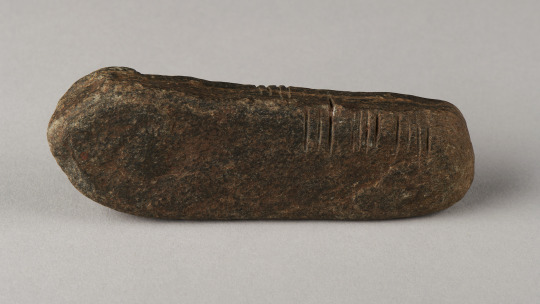
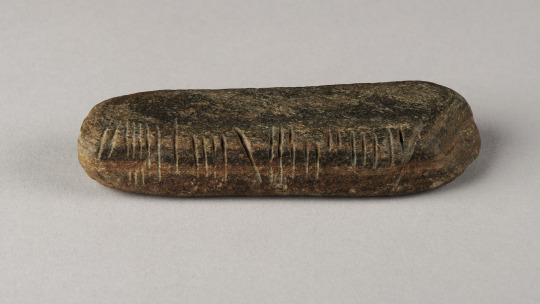
Stone With 1,600-Year-Old Irish Inscription Found in English Garden
A geography teacher, Graham Senior, stumbled across a rock with mysterious incisions while tidying his overgrown garden in Coventry, England. The discovery of a small stone carved with an early form of Celtic script has caused excitement among archaeologists.
The rectangular sandstone rock was found by Graham Senior in Coventry during lockdown in 2020 while he was weeding, but its true value was only recently understood.
The 11-centimeter-long and 139-gram rectangular sandstone rock had cryptic inscriptions on it that suggested a history spanning over 1,600 years, all written in the mysterious Ogham alphabet.
Ogham is an early medieval alphabet used to write the Archaic Irish language from the 4th to the 6th century and Old Irish from the 6th to the 9th century. It is usually found carved on stones in Ireland, Wales, and western Britain. It was the first written language in Ireland. The majority of the 400 or so known inscriptions from the Archaic Irish period are family name pillars that were built to announce land ownership.
Ogham is an extremely unique writing system among all writing systems, with lines arranged in groups of one to five only. The stones provide insight into the Irish language before the use of the Latin insular script.
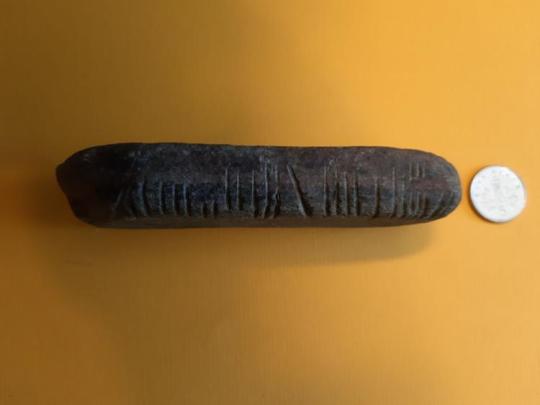
Finds liaison officer for the Birmingham Museums Trust, Teresa Gilmore, told RTÉ’s Morning Ireland that the discovery on an Ogham stone in the English midlands was a rare find.
“These finds do not turn up in the midlands. The bulk of Ogham inscriptions are found over in Ireland,” she said.
Professor Katherine Forsyth of Celtic Studies at the University of Glasgow conducted additional research that shed more light on the stone’s provenance. Her findings point to a period suggesting a timeframe ranging from the fifth to sixth centuries, with the possibility of an even earlier date in the fourth century.

The stone is inscribed on three of its four sides. The inscription on the stone, “Maldumcail/S/ Lass,” puzzled researchers, with interpretations pointing towards a version of the personal name Mael Dumcail, but the meaning of the S and LASS is unclear. Given the usual purpose and significance of ogham stones, it may be a location reference.
Theories regarding the origins of the stone abound, with speculations ranging from migration patterns to the presence of early medieval monasteries in the region.
The rock will be displayed at the Herbert Art Gallery and Museum in Coventry, to which Senior has donated it permanently. It will feature in the forthcoming Collecting Coventry exhibition, which opens on 11 May.
By Oguz Kayra.

#Stone With 1600-Year-Old Irish Inscription Found in English Garden#Coventry England#Celtic script#sandstone rock had cryptic inscriptions#Ogham alphabet#ancient artifacts#archeology#archeolgst#history#history news#ancient history#ancient culture#ancient civilizations#celtic history#irish mythology#celtic art
205 notes
·
View notes
Text



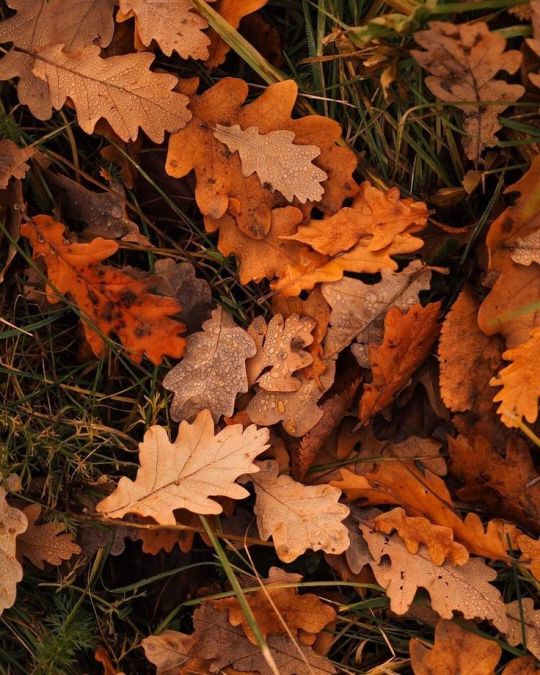


Happy (slightly) belated Mabon!
#i hope you're all having a good time#and celebrating as you see fit#personally i didn't do anything#i don't actively worship#but i've been on several walks#and the blackberries were very good this year#mabon#blessed mabon#autumn equinox#autumn#paganism#paganblr#celtic#celtic paganism#cosy aesthetic#cosycore#goblincore#naturecore#autumncore#aes
186 notes
·
View notes
Text
Someday, eventually, I will get an opportunity to talk about Celtic Apollo.
I see a lot of discussions and content (light-hearted and not) talking about Greek Apollo and Roman Apollo but y'all don't understand; it wasn't just that Greek Apollo had a second Roman Apollo hidden in his pocket, it's that Greek Apollo also has a secret third Celtic Apollo hidden behind his back like a tramp stamp he got in college and refuses to acknowledge or show to anyone.
#ginger rambles#Even then it wasn't secret or hidden at all#According to a couple sources but most relevantly Pindar Apollo would spend his winters in Hyperborea because he works entirely too much#the other nine months of the year#Hyperborea was actually England y'all it was England this whole time#It's hilarious btw because obvi Boreas the literal winter wind was the Greeks' big concept of cold? And Hyperborea was considered#even more north than Boreas hence the name and I just love the idea of the thing that is more cold than even winter itself being England#Anyway Celtic Apollo is rad as hell#He was even sycretised into a bunch of other gods because when the Romans came to do their whole conquering thing#(the first time not the time they succeeded)#They were like “gee wilkers y'all have Apollo too :0” and the Celts were like “???” because they didn't speak Latin#Anyway the real secret is that Celtic Apollo is actually at least three other Apollos in a trenchcoat#Namely Maponos Belenus and Lugh (and yes this is a fun little cross cultural equivalency thing#like the greco-egyptian pantheon equivalents#I won't call Horus Egyptian Apollo because it's more like Horus and Apollo co-evolved like brothers separated at birth#But I also definitely want to call Horus Egyptian Apollo because I'm an Apolline menace#ginger chats about greek myths#apollo#greek mythology
37 notes
·
View notes
Text

welp, that's not how I thought this design would go lol
here are the other ways I wanted it to go:


so y'know normal Victorian British thing? but then I decided I wanted him to be celtic.
SO! Nightmare is actually 2500~ish years old, he was in Britain before the Roman invasion and is a celtic pagan! (I did my best to do reasearch but if anybody can correct me on anything pls tell me, I neither want to be inaccurate or worse offensive.) I took a lot of inspo (like a lot a lot ;TvT) from the design of Viviana from Rebis:

#I like celtic folklore a lot#bc I grew up watching the asterix movies#so the gauls are very evocative to me#there's Toutatis which is the god of the tribe#and I thought it fit Nightmare a lot#I also added a cross#just cause I think If you've lived through 2500 years you've probably converted to Christianism#at least once#Vampire Nightmare Sans#college au#my art#undertale au#utmv#sans au#pigeon's art stuff#dreamtale nightmare#nightmare sans#pigeon's digital stuff
34 notes
·
View notes
Text
So okay I know I was literally just whining about school a bunch but it is definitely awesome to get to see all my (and I do have some, believe it or not) friends again! The one I was worried about was actually super chill so I think it’s fine now lol. She does have beef with my other friends though and she does still hate the friend I maybe sorta have a tiny crush on.
(Okay so that friend that I might have a crush on held my hand today when we were walking to English class and I stg I was moments away from spontaneously combusting.)

(Ignore the messy drawing lol)
She’ll be yapping about something that annoyed her meanwhile I am no longer breathing and by some miracle she remains completely oblivious.
She keeps doing stuff like this and that’s why we had so many dating allegations last year lmfao
#Okay so she has told me to my face that her type is tall strong girls#And I mean.#I’m 6ft.#I lift.#Soooo….. I’m her type?????#She’s a dance major and last year she choreographed a dance (with a group of eight dancers) as a school project#But she dedicated it to me which like#Did make me cry bc it was a really beautiful dance and so sweet of her#She also made me these super super pretty bracelets#With mushrooms and Celtic knots and purple and green beads#Plus she keeps calling me pet names#And we have gone on dates but not real dates just as friends#I just feel like if she like liked me than she’d be more nervous right?#But she’s super confident and stuff#i don’t know#Someone help me#how do you know if a girl likes you or not#Oh and sometimes she’ll just show up to school with my fav flavour of energy drink for me#Like I don’t even have to ask she’s so nice#help me#Is she just a close friend who likes holding my hand and braiding my hair or are we dating I genuinely don’t know
50 notes
·
View notes
Text
wearing a necklace so that they have something to pull on when they’re buried inside me
#was cleaning up a bit lately and found my old Celtic cross necklace I got seven years back#surely this is not a religious kink taking over#wlw and nblw only#lesbian nsft#sapphic nsft#wlw nsft#lesbian#sapphic#wlw mood#wlw yearning#minors dni
40 notes
·
View notes
Text

Happy Equinox!
#ostara#spring equinox#vernal equinox#spring#first day of spring#fresh start#rebirth#transformation#spring is here#spring time#spring 2024#ostara aesthetic#wheel of the year#solar year#solar#spring garden#spring cleaning#spring awakening#spring flowers#spring aesthetic#spring magic#spring nature#spring vibes#witches#pagan#celtic paganism#paganism#pagan festival#pagan ritual#pagan witch
50 notes
·
View notes
Text
Lughnasadh in the Modern Day
The ancient festival of Lúnasa is one of the 4 celtic fire festivals celebrated on the turn of the seasons. The other 3 festivals all have very clear christian reinterpretations. Those being All Hallows Eve, St Brigids day and May day. However Lúnasa also has a number of modern day christian holidays associated with it in much the same way.
(Linked sources in brackets)
Names
The modern festival goes by many names: Domnach Lúnasa, Lá Lúnasa, Domnach Crom Dubh, Bilberry Sunday and most commonly as either Reek Sunday or Garland Sunday. (1)(2)
Hill Climbing & Holy Wells
This is a day where the mountain of Croagh Patrick is visited, the pilgrimage consists of climbing the mountain while taking stops at certain stone cairns, where one walks in circles around them a set number of times while reciting specific prayers. There are 3 major sections where this is done(3). This is still observed today(4). It is celebrated on the last Sunday of July.
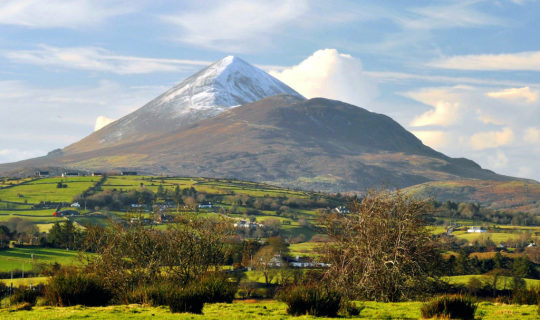
(Croagh Patrick)
This, while observed throughout the country, is not the only such celebration. Many towns climb their respective hills on this day such as those around Keash Hill in Sligo(2)(5)(11), Slive Donard in Down(6), and Máméan in Galway (7). Holy wells are also visited on this day such as in Cappagh, Galway(8), Ballyfa, Galway(9) and Ballyhaunis, Mayo (12). In some cases a procession from the Holy Well to the hill takes place (2)(7)(11)
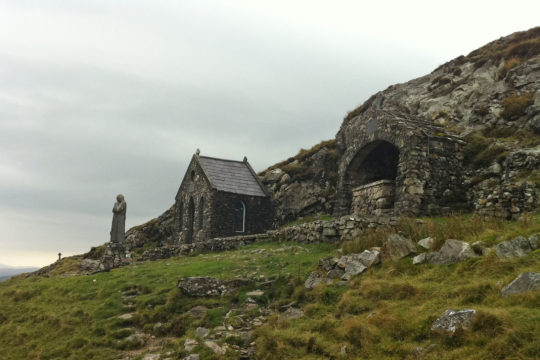
(Máméan)
An interesting example of this was the Tullaghan Hill holy well in county Sligo, where the Holy Well was on a hill specifically the Ox mountains. This specific well used to be visited on Garland Sunday but is no longer as the festival that followed this visit evoked too much "secular fun" (10).
Festivals
Fairs and celebrations seem to be a core feature of this Lúnasa Tradition, with the aforementioned Tullaghan Hill fair, The Old Fair Day in Tubbercurry, county Sligo (13) and Fair Day in Kenmare, Kerry(14). These are usually celebrated in the second week on August, i.e. a week or two after the religious excursion.
The Puck Fair is festival in Killorglin, county Kerry. It is celebrated in the second week of August and involves crowning a specific goat "king" and parading them around while a large fair takes place(15).

(Puck Fair)
Mythology
In the dinseanchas entry for Nás, the death and burial of two of the wives of Lugh are described, with Bui having been buried on the Hill of Cnogba. Where it is said that "The hosts of the pure Gaels came to bewail the women". Suggesting that there was a precession to the Hill she was buried. There was then said to be mass mourning which grew into a great assembly. These events were said to have contributed to the beginning of the festival of Taltiu, which is to say Lúnasa. (16)
Pagan Connection
The pagan connection is quite clear to see, with Holy wells long being sites of pre-Christian worship, it is little coincidence that they are visited around the time of Lúnasa. The climbing of a hill seems to be widely practiced over the country and directly connects to the Dinseanchas story of the beginning of the Lúnasa festival in where a hill was climbed to reach a grave for mourning. The fact that Keash Hil (Ceis Corran) and Croagh Patrick are both home to ancient megalithic cairns, which are commonly connected with the Otherworld is also an interesting point.
Lúnasa being an Aonach, a funeral festival for the foster mother of Lugh, Tailtiu does tie directly into the occurrence of festivals around this time.
Practices to Adopt
It seems clear now that visiting watery sites such as wells and climbing hills to worship, as well as large scale festivals and merriment are a key part of how Lúnasa has continued to be celebrated and should be incorporated into a modern Irish pagan practice.
#irish paganism#celtic paganism#gaelic paganism#ireland#féile#Lúnasa#lughnasadh#irish reconstructionist#irish reconstructionism#irish polytheism#celtic polytheism#gaelic polytheism#wheel of the year#witch#witchblr#paganism#the source numbers got a little out of order dont mind that though#irish mythology#mine
211 notes
·
View notes
Text

Happy Midwinter and Blessed Imbolc ❄️🌸
Spring is just around the corner
#imbolc#st brigid's day#st brigid#cross quarter day#pagan#wicca#spring#celtic#winter#midwinter#wheel of the year#moodboard
110 notes
·
View notes
Text

All About Lughnasadh
Lughnasadh, also known as Lughnasa or Lúnasa, is the name given to the Gaelic festival that represents the beginning of the harvest season, which traditionally falls on August 1st in the northern hemisphere. The holiday is about halfway between the summer solstice and autumn equinox, and is one of the 4 Gaelic seasonal festivals. Although it is traditionally Irish, many neopagans celebrate the holiday as well.
Traditionally named after the Irish God Lugh, Lughnasadh has been documented to be celebrated since at least the middle ages and involved great gatherings, ceremonies, athletic games like the Tailteann Games, feasting, horse racing, matchmaking, trading, and more, and were traditionally celebrated on top of hills and mountains. The festival remained widely celebrated until about the 20th century, where it seemed to be replaced by Christian counterparts.
Lugh, the God the festival is named after, is said to have founded the holiday as a funeral feast and funeral games to commemorate the death of an earth goddess. The Irish stories vary throughout regions and times, but it usually involves a woman who is stolen away or held against her will and dies of grief, shame, exhaustion, or unspecified causes. There is notable similarities to the Greek Persephone tale. According to a tale about the Lughnasadh festival site Tailtin, it is said to be a funeral for his foster-mother, Tailtiu, who was said to have died from exhaustion after clearing the plains of Ireland for agriculture. A tale about the Lughnasadh site Naas, says the festival was founded in the memory of his two wives, Nás and Bói. Another theory states it was a mourning for the end of summer.
Máire MacNeill, a folklorist, studied the later lore of the holiday and claims it is about a struggle for the harvest between Lugh and another god, often named Crom Dubh. In some stories Lugh must seize Crom Dubh's treasure of grain to give to all of mankind. In other stories, it's over a woman named Eithne who represents grain. Othertimes, its a battle of Lugh defeating a figure representing blight. There doesn't seem to be one agreed upon legend, other than it's revolving around the God Lugh.
As for ancient customs and traditions, they can vary region to region and have morphed throughout time. However, a big tradition was the gathering at Óenach Tailten, a type of olympic style games and gathering where kings declared truces during the entire festival in order to partake and compete against eachother. It included ritual athletic and sporting competitions, horse racing, music and storytelling, trading, law-making and settling legal disputes, creating contracts, and even matchmaking. A common matchmaking tradition was allowing couples to enter a trial marriage that lasted a year and a day by joining hands through a wooden door, after of which they could make permanent or break without consequences once the trial marriage was up. One gathering, called the Óenach Carmain, also consisted of a food and livestock market along with a market for foreign traders.
Other traditions also included a solemn cutting of the first corn to be offered to the deity by bringing it to a high place and burying it, a meal for everyone consisting of the new food and blueberries, a sacrifice and rituals involving a sacred bull, a ritual dance-play, reenactment of the lore, and closing ceremonies. Climbing hills and mountains were also a popular tradition, but has been rebranded overtime as Christian pilgrimages. At some gatherings, everyone wore flowers and climbed a hill, where they buried said flowers at the top to signify the ending of summer. At other gatherings, the first sheaf of harvest was buried instead.
A popular tradition up until about the 18th century were faction fights where young men fought eachother with sticks. One such game consisted of building towers of sod topped with a flag to defend from the other team's sabotaging. Bull sacrifices were also recorded into the 18th century, being used as offerings to various deities, along with special meals made from the first harvest. A special cake called the lunastain was also recorded. Visiting holy wells was also a very prominent tradition, just like during the other yearly festivals. Although bonfires were associated with Lughnasadh and the other main Celtic festivals, they were considered rare for this holiday, most likely due to the very warm summer temperatures.
Some traditions are still celebrated today in Ireland, with festivals being held in honor of Lughnasadh and re-enactors and historians reviving and teaching new generations old lore. There are still markets, traditional dancing, traditional storytelling, arts and craft workshops, feasting, and much more during these modern gatherings, keeping the traditions alive and well, even if they differ region to region. Some pagans and Wiccans also celebrate Lughnasadh, usually differing in their practices, but still using it as a signifier of the first harvest and summer's ending.
Lughnasadh Associations
Colors - yellow, orange, red, brown, green, gold, bronze
Food - blueberries, blackberries, grains, fruit, vegetables, bread, corn, beef, stews, lamb, wine, beer, cider, fruit drinks
Animals - bulls/cows, roosters, sheep
Items - scythes and harvest tools, grain/corn stalks
Crystals - citrine, aventurine, tigers eye, carnelian, topaz
Other - sporting/athletic competitive games, storytelling, matchmaking, cycle of life, harvest
Ways to celebrate:
gather blueberries or blackberries
enjoy grains or breads
make homemade bread
have a feast
climb a hill/take a pilgrimage
offer food to your deity(ies)
commit or recommit to your partner
harvest fresh food from your garden
visit a farmers market
complete a craft or make art
participate in an athletic competition or game
#witch#witchcraft#magick#magic#lughnasadh#lunasa#celtic pagan#eclectic pagan#wiccan#wicca#wheel of the year#sabbath#lammas#lugh#deity#offering#pagan holiday#irish holiday#witchy#spiritual#witchblr#pagan#grimoire#witchcore#harvest#irish#celtic#gaelic#spellwork#paganblr
47 notes
·
View notes
Text

Metal Detectorist Finds Rare 2,000-Year-Old Celtic Coin
A metal detectorist says he did a “jig of joy” after turning up an “exceptionally rare” 2,000-year-old Celtic coin worth thousands of pounds.
Grandfather Mike Taylor couldn’t contain his excitement after finding the rose gold stater while searching farmland in Bishton, near Gwent, South Wales.
fter getting an “iffy” signal from his detector, he dug down four inches before uncovering the coin, struck during the reign of Antedios, an Iceni ruler, from 20-47AD.
The incredibly detailed coin, thought to be worth £4,000, depicts a triple-tailed horse alongside a cross, crescent, six-spoked wheel and pellets.
It bears the tree emblem of the Dobunni, an Iron Age tribe living in Britain prior to the Roman conquest.
The name of Antedios is inscribed in full with a Greek letter, which is unusual as abbreviations were more common.
A Timeline Auctions spokesman said: “This variant is rare because it features the complete name of the ruler, unlike most coins where part of the name is missing.
“Additionally, the ruler’s name is inscribed with the Greek letter Θ, whereas it is usually written with the letter ‘D’. It is a well-centred example with sharp details.
“Only one other example with this lettering is recorded, and our example also includes three extra pellets behind the tail. This makes it an exceptionally rare and beautiful coin in lustrous rose gold.”
Antedios remained neutral during the Roman invasion of 43AD and was made a client of Rome.

#Metal Detectorist Unearths Rare 2000-Year-Old Celtic Coin#Bishton South Wales#Iceni tribe#reign of Antedios#Iron Age triple#coin#celtic coin#collectable coins#ancient coins#ancient artifacts#metal detector#metal detecting finds#archeology#archeolgst#history#history news#ancient history#ancient culture#ancient civilizations#roman history#roman empire
54 notes
·
View notes
Text
non-irish people reading 'gailege' and 'gaelic', the names of two completely distinct celtic languages

#languages#irish#gailege#gaelic#celtic languages#sorry to the person who posted that poll but c'mon#it's been 12 years since tfa came out#there is no excuse#'google isn't helpful' did you actually google it or did you take fics written by non-irish americans at face value#'what language do they speak in ireland' will get you irish and english at the very top of the screen
152 notes
·
View notes
Text
For those who don’t know, today, May 1st, is Beltane (in the northern hemisphere). Beltane is a Celtic holiday and said to be one of the three days of the year where the veil between the physical world and the spiritual word is at it’s thinnest (the other two are the Summer Solstice aka Litha and Samhain).
This is also the holiday that Arthur uses the Horn of Cathbhadh to talk to Uther in the Death Song of Uther Pendragon in season 5.
I don’t know much about this holiday—just a shallow understanding, I wasn’t raised in this culture, but am loving learning about the practices—but here is some things I know about it. Beltane literally means “the fire of Bel”. Bel is the god of the sun, and Beltane celebrates his union with the goddess of the earth, Danu. Bel and Danu are seen as the parents of the Irish gods. One of the traditions of Beltane was to put out all fires, light a sacred Bel fire, then everyone would take flames from that sacred Bel fire, and relight the fires and their hearths. So, fire is one way to celebrate Beltane. Another way is flowers. The Welsh goddess Blodeuwedd is the goddess of emotions and flowers. She is also associated with Beltane. Since Beltane is when all the flowers start to bloom and nature is vibrant, decorating everything with flowers is another Beltane tradition especially flower crowns.
Samhain falls on October 31st in the norther hemisphere. This is the holiday associated with the Cailleach. Samhain means “summer’s end” and the holiday is seen as the Celtic new year. Samhain is the holiday that Morgana and Morgause used to open the veil in the Darkest Hour in season 4 (if I remember right).
Why am I posting this? Because it seems like the holidays in BBC Merlin are the holidays of the Wheel Of The Year. This is useful for fanfic writers who want to expand on the Merlin world more. Or want there to be a holiday or banquet in their stories but don’t know what to make it for. Or want to try and work out a timeline for the show. Or just want to use it for tropes.
I meant this post as more a jumping off place to know where the BBC Merlin holidays originate from. I would suggest definitely researching each individual holiday more before writing about it.
I cannot stress this enough. I am not a 100% accurate source on these holidays. I think the information I have above is true, but I could be wrong. I’m very new to this.
If anyone wants to correct or add on to this that knows more, feel free to.
And to the once and future fandom, have fun researching and thinking up fun plots🫡
Ps. All the holidays are opposite in the northern and southern hemispheres because the wheel of the year follows the cycle of the seasons, so when it’s the summer solstice in the northern hemisphere, it’s the winter solstice in the southern hemisphere. When it’s Beltane in the northern hemisphere it’s Samhain in the southern hemisphere. Etc.
P.p.s. The pronunciation… 😵💫😖 it’s…it’s…it’s not what you think for like half of them. 😵💫
#bbc merlin#merlin#once and future fandom#merlin bbc#fanfiction resources#fanfic reference#fanfic research#fanfiction research#jumping off point#seriously what’s up with the Celtic pronunciations??#I was reading merlin fanfics for like a year and kept seeing the word ‘sidhe’ in so many fics#I thought it was a random monster or something from folklore that the fandom took a liking too#then I decided to look it up (FINALLY) just to see what this creature was that the fandom liked so much#and finally learned that the word ‘sidhe’ is pronounced like ‘she’ as in the pronoun#and realized all those fics I read were referring to those blue evil fairy things in canon
32 notes
·
View notes